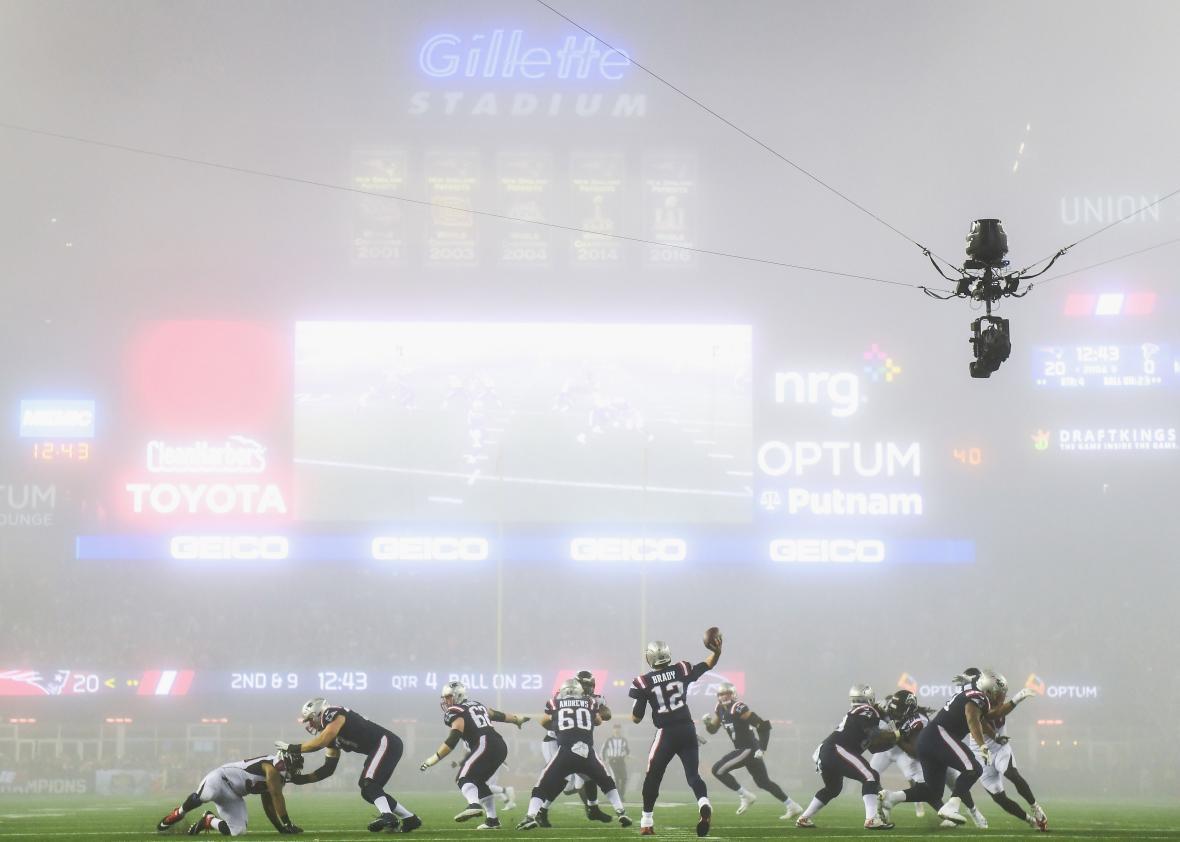On Sunday night, the Atlanta Falcons and New England Patriots reportedly faced off in a rematch of the most exciting Super Bowl in history. The Patriots, I’m told, won the game, and they didn’t have to come back from a 28–3 deficit to do so. All of this happened, if it did indeed happen, in a fog so thick that no one could see what was going on. The weather at Gillette Stadium in Foxboro, Massachusetts, was a great setting for a Sherlock Holmes story, but it was a nightmare for NBC. The players had all but disappeared into the mist.
A brief shot from the broadcast booth in the second half gave viewers a glimpse of what announcers Al Michaels and Cris Collinsworth were seeing from their vantage point. They might as well have been broadcasting from inside a marshmallow.
And then, somehow, there was light. Starting early in the third quarter, NBC’s broadcast switched primarily to Skycam, a remote-controlled camera that provides angles from above and behind the quarterback. It was a plot twist that would make Sir Arthur Conan Doyle proud, and in a game full of MVPs and future Hall of Famers, a camera suspended on wires proved the biggest star of the night.
The day after Skycam’s command performance, I reached Sunday Night Football executive producer Fred Gaudelli over the phone. “It was a lifesaver,” he said. “There’s no two ways about it.”
Gaudelli told me that he and his director, Drew Esocoff, knew at the start of the second half that they were going to need some cameras low to the ground or else the game would be entirely unwatchable.
The NBC crew had set up two separate versions of Skycam. One hung roughly 12 feet above the ground—the standard height—but they were also experimenting with an additional, higher Skycam strung 57 feet in the air. “We tested that in a preseason game in Minneapolis, where we’re doing the Super Bowl,” Gaudelli said. “We really liked it and we decided maybe we’ll bring it out for a couple select games this year … [to] give us some more practice with it.” Thanks to the Miracle Whip–thick fog, they got plenty of practice on Sunday.
Skycam is usually reserved for instant replays, so the Sunday Night Football team was in unfamiliar territory using it for extensive live shots. “The degree of difficulty is significant,” Gaudelli said. The lower Skycam, which was run by camera operator Ed Martino and pilot Cody Taylor, had to keep up with the action for most of the second half. When the quarterback throws a pass, the pilot needs to navigate the camera downfield to track the flight of the ball at the correct speed while the operator adjusts to keep the play in focus.
“The person who runs it is up in the press box, and he’s basically operating the pan, tilt, zoom, and focus with two joysticks,” Gaudelli said. “Sitting next to him is a pilot flying the camera, and they have to be in complete synchronization. They deserve a ton of credit.”
As if operating the camera weren’t hard enough, they also had to read and predict plays, much like defensive coordinators. “I usually tell [the Skycam operators], if you think it’s going to be a running play, come up a little higher because you see the blocking in front of them a little better,” Gaudelli said. “If you think it’s going to be a passing play, lower it because then you can see almost like what the quarterback sees as he’s looking downfield at his receivers.”
Operating the higher camera were Darin Haggard and pilot Raubyn Pointer, who had to deal with the challenge of using an incipient device in foggy conditions. This Skycam wasn’t deployed to show as much live play-by-play action as its lower counterpart, but it did provide wider angles for dramatic establishing shots. “We had two really good-looking cameras last night,” Gaudelli said.
The executive producer was not entirely surprised that the views were a hit. “Halfway through that second half I thought, There are going to be people calling for this to be the main angle from now on,” Gaudelli said. He thinks Sunday’s broadcast got so much acclaim because the football-watching masses have grown familiar with the camera angle, which has been a staple in football video games for decades. “There are generations of football fans who really kind of learned about football, or experienced a lot about football, through Madden.”
While Skycam came through in a pinch, relying on it as the main vantage point for every broadcast is a tough ask. “There are some drawbacks,” Gaudelli told me. “If it’s windy, it’s sometimes hard to keep the shot stable. When it’s raining really hard, the lens becomes compromised by raindrops.” During stormy games, the operators lower the cam down to the field during commercial breaks to shammy off condensation. “If you had a six to seven minute drive, you’re not wiping it clean.”
Still, the success of the flying camera was not lost on Gaudelli, who says he’s giving serious consideration to using it more extensively during future games. Sunday Night Football heads to Detroit next and, in case you were wondering, the forecast for the the Lions’ indoor stadium doesn’t call for fog.
